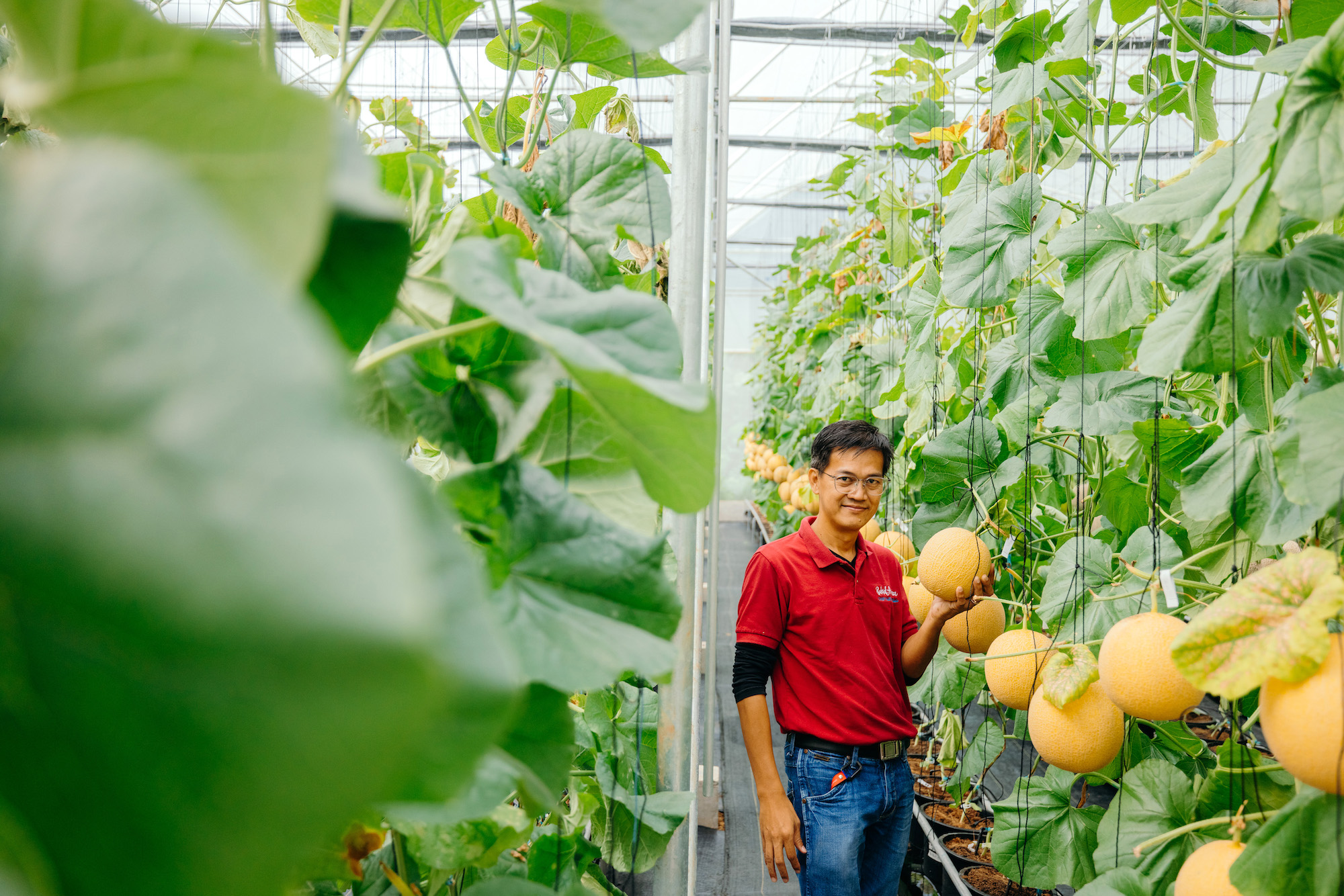There is nothing quite like the sight of flora in full, spellbinding bloom. Rows of multicolored blossoms blending into the kaleidoscopic scene—it’s enough to make any tourist swoon.
This is probably why the lavender fields of Provence hold such prominence in collective memory. East Asia’s cherry blossoms alone have inspired countless festivals, celebrations, and global tourism campaigns. The Netherlands’ tulip farms are nothing short of iconic; the list goes on.
While there are popular flower farms sprinkled across the archipelago, too, none are like Bukid Amara, where the ‘bukidscape’ is inspired by National Artist for Visual Arts Fernando Amorsolo’s renderings of the Philippine idyll.
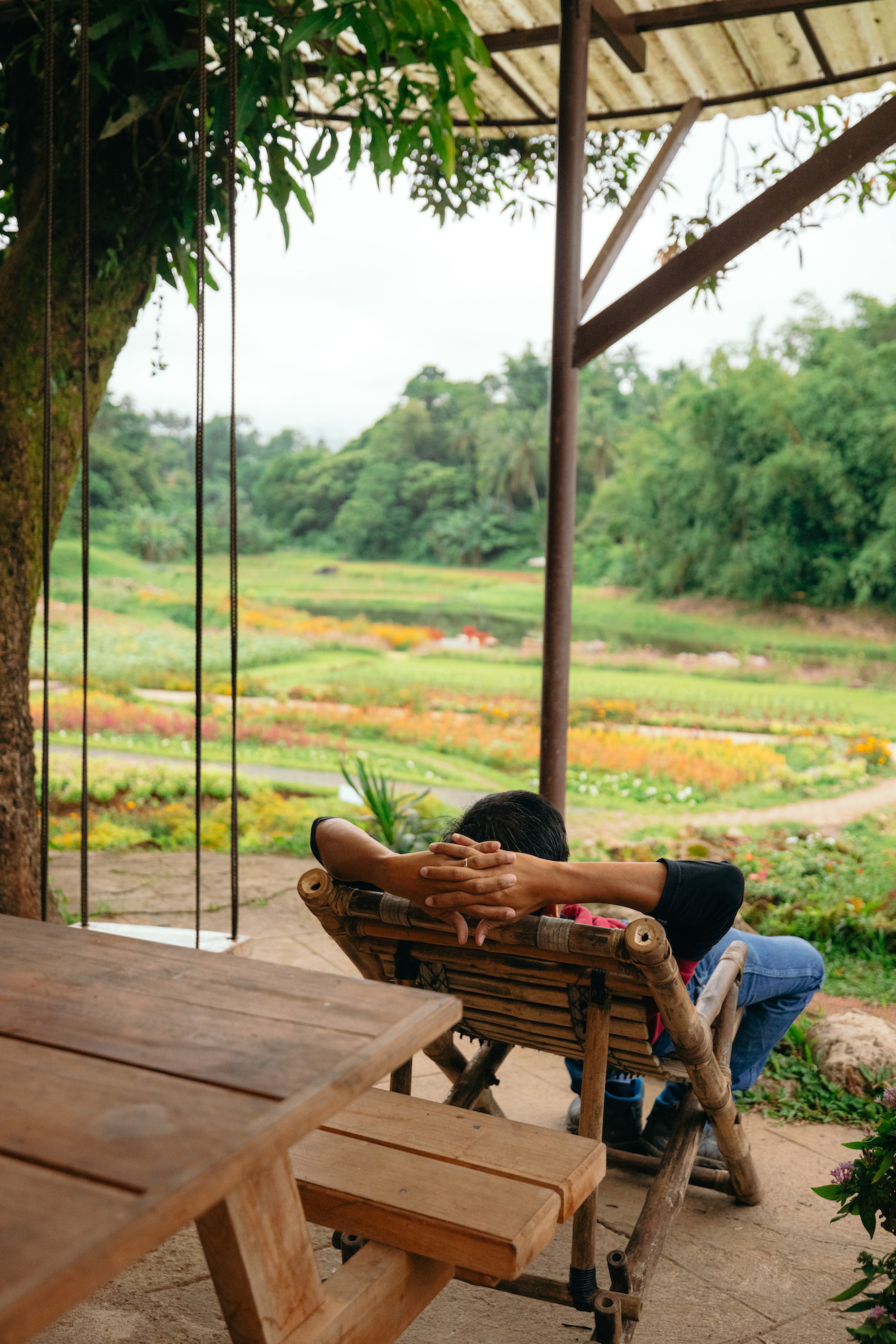
Your first few minutes within the farm’s premises is a welcome assault to the senses: fresh, cool air, the cacophony of birds mingling with the soft pit-pattering of Lucban’s characteristic rain showers, and the colors—you can’t miss them. Lots filled with gloxinias, sunflowers, marigolds, and African daisies, whose velvety flowers catch dew in the morning. Fluffy stalks of celosia and blue salvia dancing in the wind. A sprinkling of local wildflowers just by the fish pond—haven for the wild lukot or stingless bees that buzz through the foothills of Mt. Banahaw.
“We created a farmscape or ‘bukidscape’ na mala-Amorsolo ang dating. Mayroon kang Mt. Banahaw sa likod, andyan ang mga kubo, ang palayan at mga bulaklak. We plant depending on the season. We can play around with the [flowers’] color palette, depending on the mood we’re going for,” Michael Caballes says.
If you’re lucky, the mystical mountain makes an appearance when skies clear. Sightings of Mt. Banahaw towering over the Bukid Amara may be as quick as the clouds passing by, but they are glorious nonetheless.
Bukid Amara: A learning showcase, an artful ‘bukidscape’
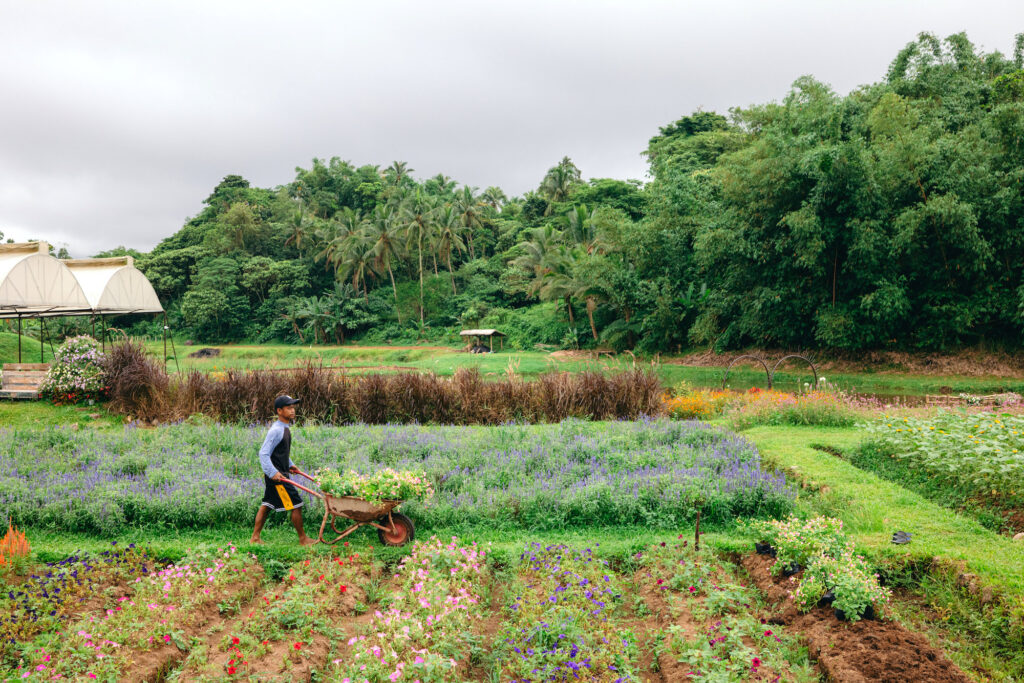
“We created a farmscape or ‘bukidscape’ na mala-Amorsolo ang dating. Mayroon kang Mt. Banahaw sa likod, andyan ang mga kubo, ang palayan at mga bulaklak. We plant depending on the season. We can play around with the [flowers’] color palette, depending on the mood we’re going for,” Michael Caballes says.
There are about 50 to 60 varieties of shockingly vibrant flowers blooming in Bukid Amara at any given time and to add to the multisensory experience, some of them are lovely on the palate; edible flowers like angelonias, zinnias, begonias, and cosmos. It’s a flower fiesta, all day, year-round.
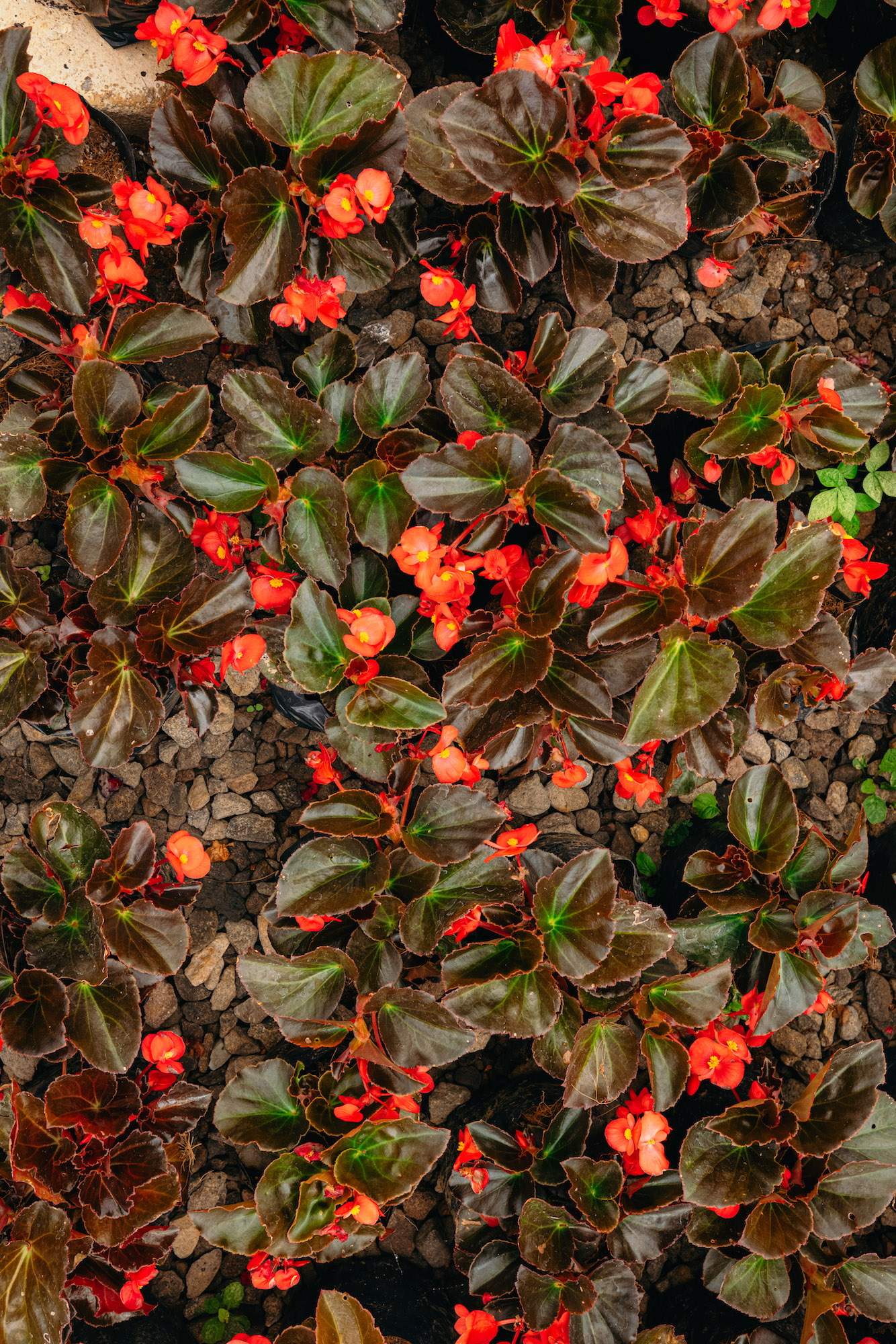
“This is our office,” beams Caballes, who established Bukid Amara in 2018. The 2.7-hectare site is a showcase for many groundbreaking offerings unique to Bukid Amara. It is a showroom for what a future in precision farming and smart agriculture can look like.
Among Bukid Amara’s laudable features are farm tourism or agritourism areas dedicated to Instagrammable flower fields, edible flowers, and high-value crops like melons. This encourages visitors to not only visit for the sake of tours and photo ops but also to engage in valuable interactions and activities on the farm such as melon tasting, which can quickly turn into a jam-packed learning session with Bukid Amara’s in-house agriculturists.

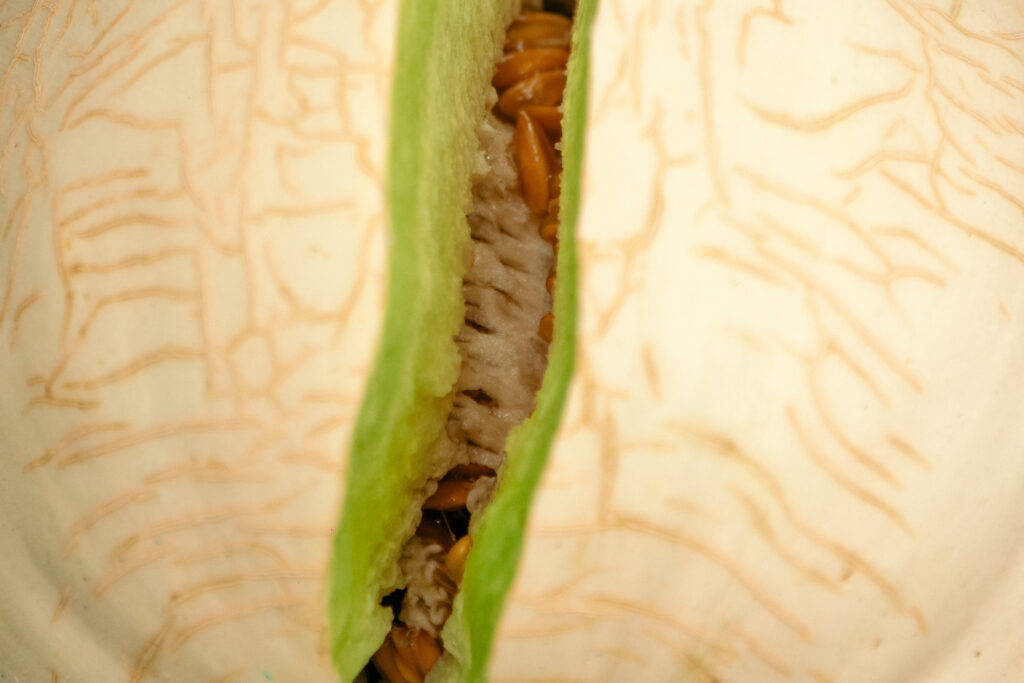
Then, there are the farm’s provisions for precision farming or smart agriculture with the latest innovations on full display: greenhouses equipped with cloud-based automatic dosing systems, an admirable aquaponics setup, areas for urban farming, and more. All these are in line with Caballes’ eagerness to give back to the community by way of agricultural advancement, knowledge exchange, skillset building, and hands-on training.
If a visit to Bukid Amara inspires farmers and agriculturists to progress in their respective fields and make contributions to the industry, then the farm will have served its purpose. If it awakens farming interest in individuals and groups yet to dabble in agriculture, all the better. Because even as a corporate man in agriculture, Caballes knew that food security has to be everyone’s business.
A time to ‘live the change’: From a 9-to-5 to the farm life
Up until 2018, for 21 years, Caballes—an agriculturist by profession—dealt with the hustle and bustle of Quezon City on a daily basis as a corporate executive of a popular seed company. Now, he enjoys his days as chief farmer of Bukid Amara, where he employs a full-time staff of 16 people and counting.
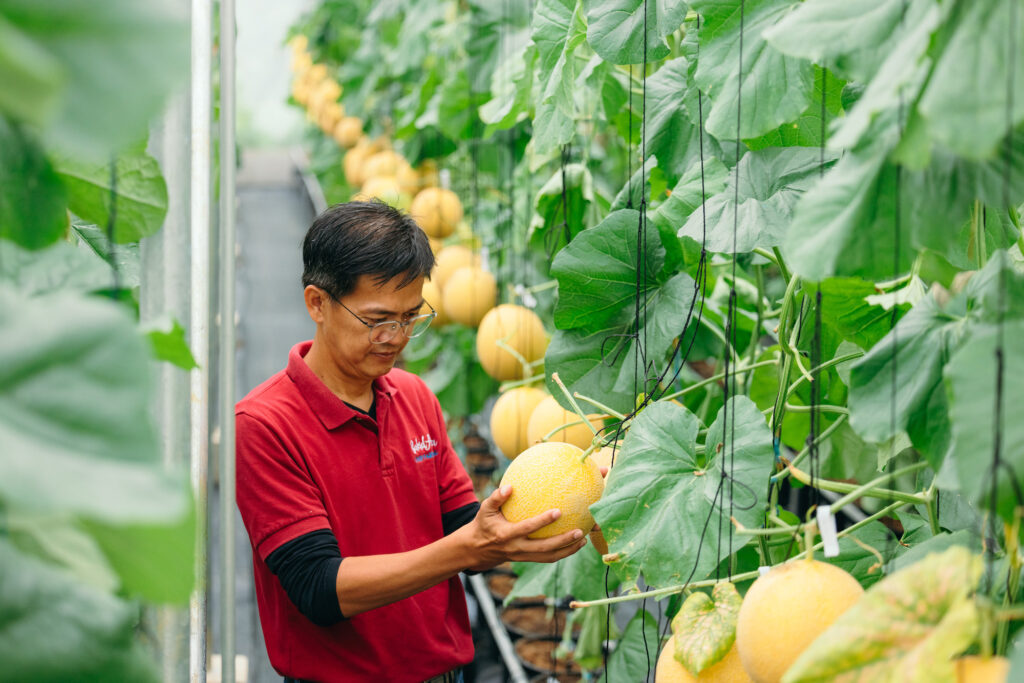

No doubt his career at the office was rewarding but as is usually the case with high-stress nine-to-fives, it came with life-bending pressure. About two years prior to moving back to his hometown in Majayjay, Laguna, Caballes and his wife decided it was time to map out their early retirement. They had a good run with the corporate scene but a change of pace was essential to the life they envisioned for themselves long-term. They figured it was time to “live the change” they wanted—and the best time to start was now.
“In a company, it’s never-ending growth and it is financially rewarding, but there are times when the spirit suffers. The health suffers. The mind suffers,” Caballes says as he recounts the peak of his corporate career.
So, the Caballeses traded their office routine in Quezon City for more manual labor in Quezon Province, where the first order of business was to build Bukid Amara in Lucban. Interestingly enough, the daily drive to Bukid Amara from their home in Majayjay only takes a consistent 25 minutes—far less than the time they’d spend stuck on the road in Quezon City in rush hour.
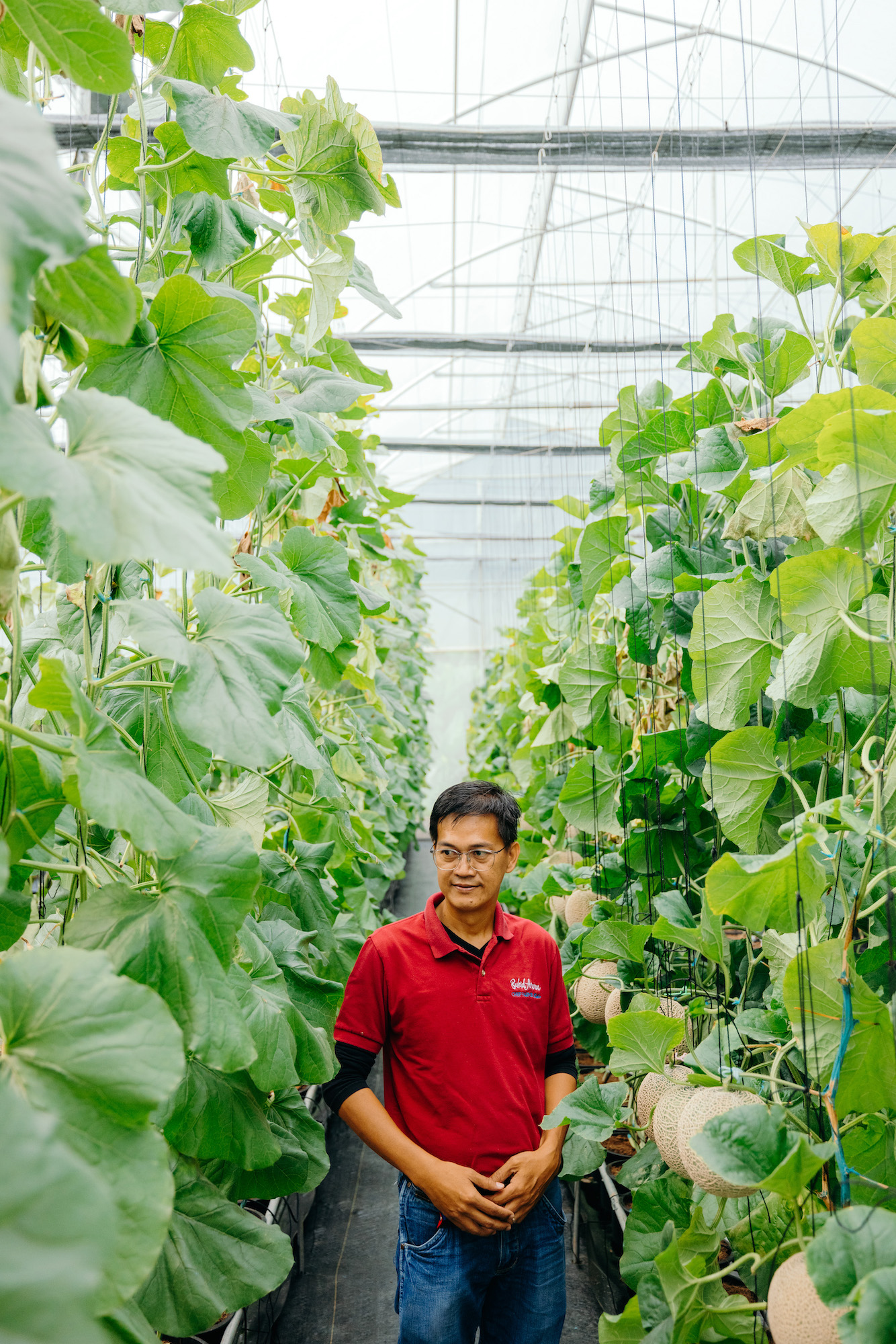
“In a company, it’s never-ending growth and it is financially rewarding, but there are times when the spirit suffers. The health suffers. The mind suffers,” Caballes says as he recounts the peak of his corporate career. When he was not in his office in Quezon City, Caballes would visit different farms across the Philippines promoting his company’s seeds. The industry, while cutthroat, provided the best experience and background for envisioning and eventually establishing Bukid Amaya. Interacting with various farms here and abroad sharpened Caballes’ nose for figuring out what farmers need to thrive and succeed.
“That was 21 years of my city life. After five years of living here [near Bukid Amara], we don’t want to go back to Manila anymore. Here, we focus more on health and family.” Of course, beyond this, Caballes’ daily focus is the farm.
Making a sharing culture thrive in agriculture

To ensure the farm’s success, Caballes carries out Bukid Amara’s establishment in three tiers; there are plans for short-, mid-, and long-term. Long-term plans include a living museum of Philippine endemic fruit and flowering trees—yet another project that will add dimension to the farm’s already colorful palette.
Now, the farm is at mid-term growth and in all stages of its development, one thing stands out: Caballes’ drive to keep sharing—technology, know-how, skill sets, wisdom. For the agriculturist, it’s about time farmers break the cycle and culture of turfing in the industry.
“There’s no secret in farming. Everything can be learned. Everything can be taught. Some people would like to keep certain knowledge, systems, and tools to themselves but it’s not right. In order for the industry to grow and thrive, you have to share,” says Caballes, who is also a Go Negosyo mentor.
“There’s no secret in farming. Everything can be learned. Everything can be taught. Some people would like to keep certain knowledge, systems, and tools to themselves but it’s not right. In order for the industry to grow and thrive, you have to share. Since you don’t want to share, we’ll share. Nobody in the Philippines wants to share this technology? We’re willing to,” says Caballes, who is also a Go Negosyo mentor.
In line with this advocacy, aside from making the business run smoothly through various revenue streams, Caballes dedicates a portion of Bukid Amara to capability training, skills development, and market linking and matching. These offerings are for farmers and practically anyone who would like to contribute to the modernization of agriculture in the Philippines.
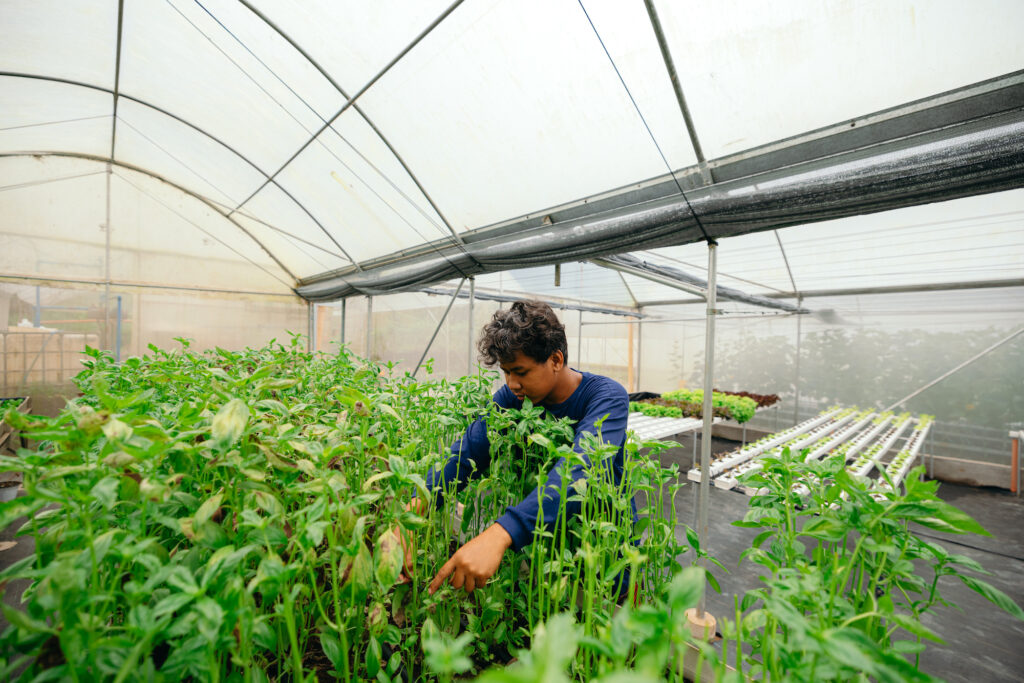
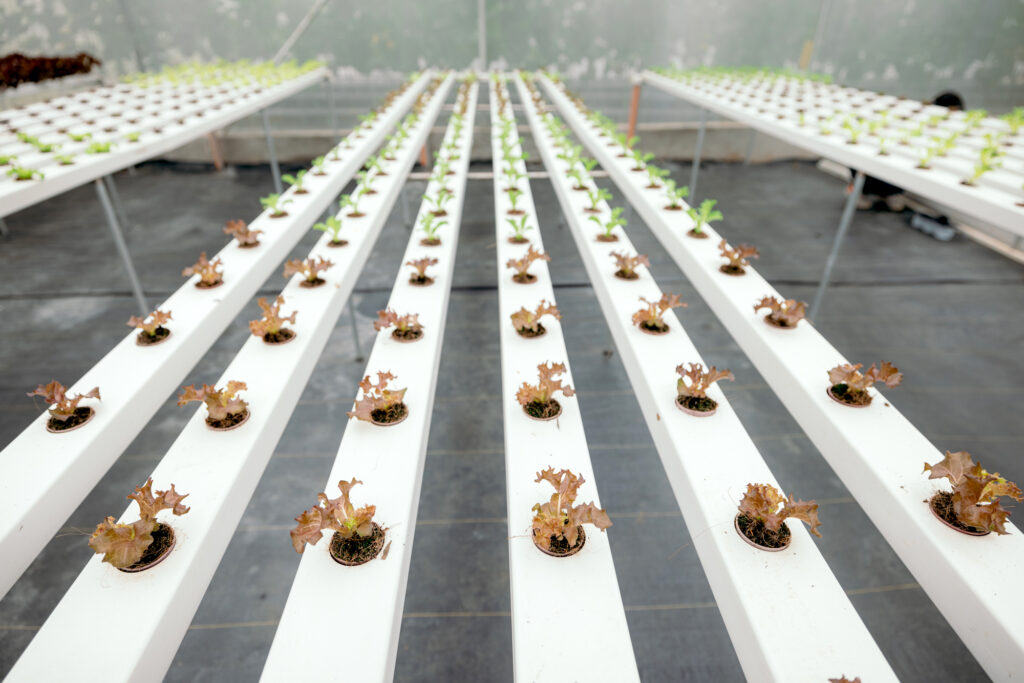
Not only is Bukid Amara fertile ground for all of the crops and blooms it grows and harvests, it is also abundant in opportunities. Here, there is ample hands-on training for farmers and agriculturists, exposure to technology and key players in the business, and a mentor like Caballes who is on legacy mode. What he knows, he’d like to pass on.
“At the moment, one of the missions of Bukid Amara is to help however we can to contribute to the modernization of agriculture through capability building. That’s why we’re aspiring to be one of the leading learning sites for precision farming or smart agriculture, where we employ modern technology, data analytics, AI, and the Internet of Things into farming,” Caballes explains.
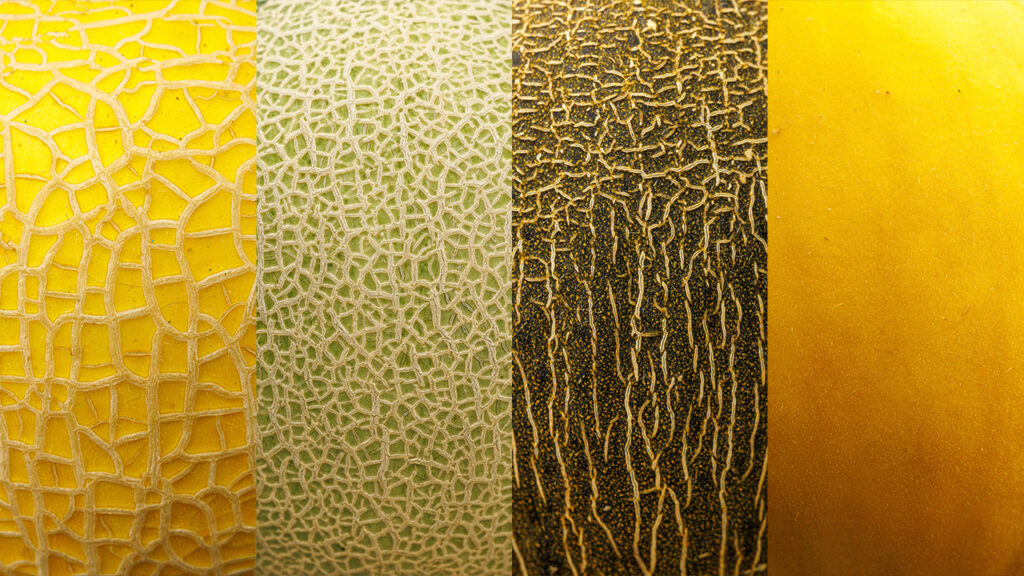
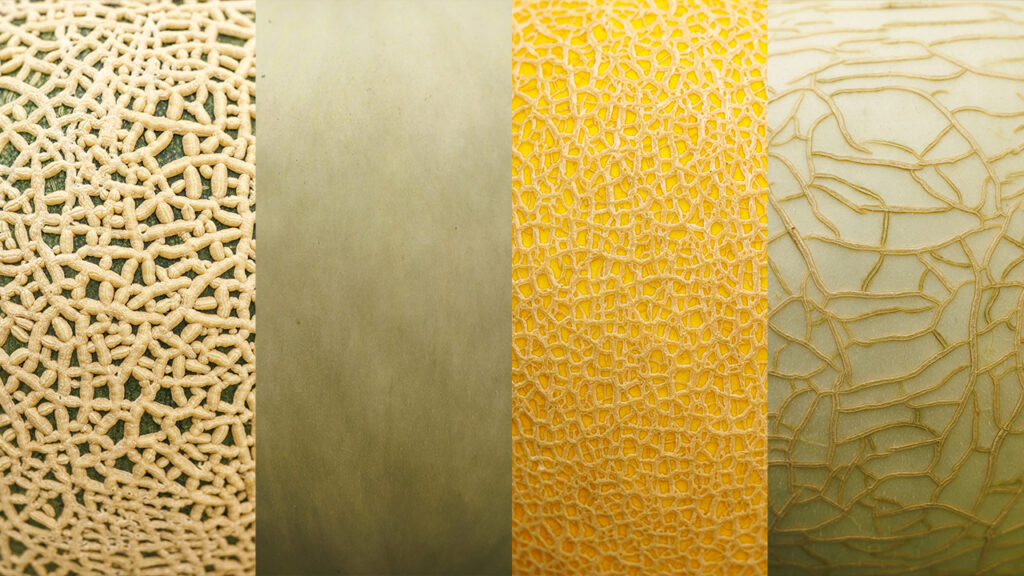
Bukid Amara is now a learning site accredited by the Agricultural Training Institute and supported by the Department of Science and Technology. The farm constantly collaborates with the Department of Tourism, Department of Agriculture, Department of Trade and Industry, and farmers associations within the communities Caballes works with.
Bukid Amara also acts as a learning hub and testing ground for students of universities whose programs focus on agricultural advancements: University of the Philippines Los Baños, Batangas State University, Laguna State University, and Southern Luzon State University, among others. They’re eyeing partnerships and accreditation with the Technical Education and Skills Development Authority next.
Committing to a farmer’s life at Bukid Amara

While Caballes believes in empowering Filipinos all over to advocate for food security in ways most convenient for them (such as urban gardening and patronizing local products), he acknowledges that the farmer’s life isn’t an easy one. “Agriculture is not just cultivating the land. That’s just one part of the job,” he quips. And this is one thing they constantly teach at Bukid Amara: That farming is a multifaceted occupation that will force you to wear many hats and make many mistakes. In any farm, there is endless value in learning by doing and in showing up every single day despite factors out of your control.
“At the learning site, we don’t do training by slideshows. We do it through actual practice. You come over, you see what we do, we show you how to do it realistically and practically. We teach you the risk factors. We’re not going to sugarcoat. We tell you what you can expect,” says Caballes, who stresses that these expectations include problems you will encounter, troubles you can expect, crises you will mitigate.
“Agriculture is not just cultivating the land. That’s just one part of the job,” he quips.
At the end of the tunnel, though, comes light in the form of advancements and precision farming solutions—which ties back to one of Bukid Amara’s major pillars. Caballes calls out to budding farmers, agriculturists, and future generations and challenges them to help the Philippines catch up to Asian neighbors who are decades ahead in agricultural systems and practices. Amusement and disappointment furrow along Caballes’ brows when he shares that some of the farming equipment still in use in the Philippines today are already museum pieces in other countries.
“With the technology now, ang agrikultura, naka-app na. We have the technology. We can do it. We can teach you how to use it, too.”
But somewhere between Philippine agriculture’s former glory and the future we hope for it to have, Lucban’s incessant rain brings Caballes back to the present. Right now, he is a farmer worrying about his flowers and crops.
“We are always at the mercy of the climate. Habang nag-uusap tayo, my mind is set on those flowers I put up because I know matutunaw ’yan bukas. Habang tayo nag-uusap, at the back of my mind are my petunias. I know this rain will destroy it. Then I wouldn’t have a showcase,” Caballes says as he looks out onto Bukid Amara’s flower fields, now glistening with rainwater.
“This is what it is to be a farmer. It’s a wholehearted commitment.”





